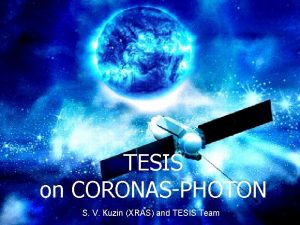MHD Simulation of PlasmoidInducedReconnection in Solar Flares K

- Slides: 1

MHD Simulation of Plasmoid-Induced-Reconnection in Solar Flares K. Nishida , M. Shimizu, D. Shiota, H. Takasaki, K. Shibata (Kyoto University) Recent space observations have revealed various evidence of magnetic reconnection and common properties in flares (plasmoid ejection, cusp shaped loops, etc. ), leading to unified view of various flares (Shibata 1996, 1999). However, the detailed physics of magnetic reconnection has not been established yet. Especially it is not revealed what determines the speed of reconnection, i. e. reconnection rate. Based on many observation, Shibata et al. (1995), Shibata (1999), Shibata and Tanuma (2001) proposed the plasmoid-induced-reconnection model, which suggests that reconnection rate, inflow speed, plasmoid ejection velocity are closely related each other. In this study, we performed MHD simulations of solar flares with different resistivity model and different plasmoid velocity, and examined how the reconnection rate depends on the parameters. In the case in which reconnection occurs easily, reconnection rate becomes larger and consequently plasmoid velocity becomes larger. In contrast the case in which plasmoids are accelerated by an external force, i. e. in larger plasmoid velocity case, larger inflows are induced by mass conservation, and consequently reconnection rate also becomes lager. These results are consistent with observations (Shimizu et al. 2005, in preparation) and support plasmoid-induced-reconnection model strongly. Introduction Numerical Results Plasmoid-induced-reconnection model (Shibata et al. 1995; Shibata, 1999; Shibata and Tanuma, 2001) Typical case In this model, the plasmoid ejection plays a key role in triggering fast reconnection in two different ways. 1) A plasmoid (flux rope) can store energy by inhibiting reconnection, because a magnetic island (plasmoid or flux rope) inside the current sheet is a big obstacle for reconnection. Only after the plasmoid is ejected out of the current sheet, will the anti-parallel field lines be able to touch and reconnect. 2) A plasmoid ejection can induce a strong inflow into the reconnection site in order to compensate for the mass ejected by the plasmoid. The inflow speed can be estimated from the mass conservation law (assuming incompressibility, for simplicity); : The inflow speed, : The plasmoid speed, : Typical width of plasmoid, : Typical width of the plasmoid. Since the reconnection rate is determined by the inflow speed, the ultimate origin of fast reconnection in this model is the fast ejection of the plasmoid. 0. 0 In this study, we performed MHD simulations of solar flares with different resistivity model and different plasmoid velocity, and examined how the reconnection rate depends on the parameters. Pressure 2. 5 Contour: Magnetic field line Magnetic reconnection occurs at Xpoint and it creates bipolar outflows. The upward one accelerates the flux rope. Numerical Models Numerical Method We perform simulations with a multistep implicit scheme (Hu 1989) in order to solve the 2. 5 -dimensional time-dependent resistive MHD equations, which are as follows: In the case in which reconnection occurs easily, reconnection rate becomes larger and consequently plasmoid velocity becomes larger. • Case A When Case A Reconnection Rate becomes smaller, resistivity is easy to act. • Case B External force ( ) acts only inside flux rope. As a result Initial Condition The initial magnetic field configuration is shown in the right figure. This configuration is potential field created by three separate current elements (see Chen and Shibata 2000): a line current contained within the flux rope, its image current below the photosphere, and eight line currents just below the photosphere. To satisfy the force balance within the flux rope, a perpendicular magnetic component (i. e. , Bz ) was introduced inside the flux rope, indicated by the shaded region in the figure. Other quantities are set to be uniform: changes. Case B Reconnection Rate In the case in which plasmoids are accelerated by an external force, i. e. in larger plasmoid velocity case, larger inflows are induced by mass conservation, and consequently reconnection rate also becomes lager. Discussion and Summary There is a linear positive correlation between the plasmoid velocity and the reconnection rate. Moreover, there is a positive correlation between the plasmoid velocity and the apparent rise velocity of the flare loop i. e. the reconnection rate found by the observation by Yohkoh (Shibata et al. , 1995; Shimizu et al. 2005 in preparation). plasmoid velocity vs. Reconnection Rate Not only resistivity but plasmoid velocity plays an important role to determine the reconnection rate. These results are consistent with observations (Shimizu et al. 2005, in preparation) and support plasmoid-induced-reconnection model strongly.

